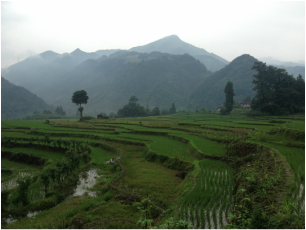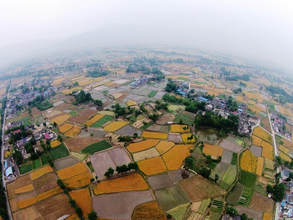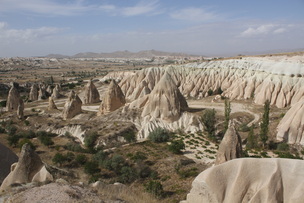Current research theme: Biodiversity conservation under forest loss, degradation, and restoration

Forest restoration is a crucial means to addressing the negative impacts of forest loss and degradation, which are among the most pressing environmental challenges to humanity. In recent years, the importance of forest restoration has come to the forefront of global policy attention, reflected by a growing number of national, regional, and global initiatives with ambitious goals. For this reason, the need for sound scientific guidance for better reaping the environmental benefits of forest restoration has never been stronger. As a main direction of my current research, I aim to explore the ecological, socioeconomic, and policy opportunities for making biodiversity gains under forest restoration.
This research direction is reflected by a set of my recent projects in China. China presents a case of large-scale forest* restoration in recent decades, thanks in part to a system of state policies on forest protection and restoration. There are indications, however, that much of China's forest recovery is accounted for by tree plantations rather than native forests, suggesting environmental implications potentially more complicated than simply represented by forest cover, particularly for biodiversity. Focusing on a region in Southwestern China between 2000-2015, my colleagues and I combined remote-sensing analysis with household surveys to explore the nature and drivers of the region's recent, apparent forest recovery. In addition, we conducted biodiversity surveys and socioeconomic analysis in the region to assess the biodiversity implications and socioeconomic feasibilities for better biodiversity outcomes under the Grain-for-Green Program, the region's most prominent reforestation program that is also the world's largest of its kind. More broadly, we analyzed the policy changes needed for China to better recover its native forest landscapes. [*: "forest" here adopts the FAO definition, and covers a wide range of tree-cover types ranging from native forest to intensively managed plantations. A more accurate term here would be "tree cover".]
These projects are in collaboration with research groups from the Kunming Institute of Zoology and the Kunming Institute of Botany (both of the Chinese Academy of Sciences), Sichuan University, the University of Vermont, and Princeton University.
The same research direction is further reflected by two of my ongoing projects, whereby I aim to (1) assess the extent to which China's forest restoration may lead to "leakage" effects on the land use and biodiversity conservation of foreign countries that are mediated through the international trade of agricultural and forestry commodities, and (2) assess the synergy and tradeoff between biodiversity and ecosystem services under forest restoration. The former project is in collaboration with the University of Cambridge, the International Institute for Applied Systems Analysis (IIASA), and the Chinese Academy of Sciences. The latter project is in collaboration with the University of Cambridge, the University of São Paulo, the University of Amsterdam, the University of Sheffield, and the University of Aberdeen.
This research direction is reflected by a set of my recent projects in China. China presents a case of large-scale forest* restoration in recent decades, thanks in part to a system of state policies on forest protection and restoration. There are indications, however, that much of China's forest recovery is accounted for by tree plantations rather than native forests, suggesting environmental implications potentially more complicated than simply represented by forest cover, particularly for biodiversity. Focusing on a region in Southwestern China between 2000-2015, my colleagues and I combined remote-sensing analysis with household surveys to explore the nature and drivers of the region's recent, apparent forest recovery. In addition, we conducted biodiversity surveys and socioeconomic analysis in the region to assess the biodiversity implications and socioeconomic feasibilities for better biodiversity outcomes under the Grain-for-Green Program, the region's most prominent reforestation program that is also the world's largest of its kind. More broadly, we analyzed the policy changes needed for China to better recover its native forest landscapes. [*: "forest" here adopts the FAO definition, and covers a wide range of tree-cover types ranging from native forest to intensively managed plantations. A more accurate term here would be "tree cover".]
These projects are in collaboration with research groups from the Kunming Institute of Zoology and the Kunming Institute of Botany (both of the Chinese Academy of Sciences), Sichuan University, the University of Vermont, and Princeton University.
The same research direction is further reflected by two of my ongoing projects, whereby I aim to (1) assess the extent to which China's forest restoration may lead to "leakage" effects on the land use and biodiversity conservation of foreign countries that are mediated through the international trade of agricultural and forestry commodities, and (2) assess the synergy and tradeoff between biodiversity and ecosystem services under forest restoration. The former project is in collaboration with the University of Cambridge, the International Institute for Applied Systems Analysis (IIASA), and the Chinese Academy of Sciences. The latter project is in collaboration with the University of Cambridge, the University of São Paulo, the University of Amsterdam, the University of Sheffield, and the University of Aberdeen.

Forest loss and degradation linked to agricultural production are a leading threat to biodiversity worldwide. As the world's growing population and developing economy place higher demands on agricultural production, developing strategies to minimize the loss of forest habitat and its associated biodiversity is a central challenge for conservation and sustainability sciences.
An ongoing project of mine - which has entered the write-up phase - aims to explore the synergy and tradeoff between agricultural production and biodiversity conservation in an effort to inform land-use planning. It is set broadly under the framework of the land-sharing versus land-sparing debate, but also aims to understand the mechanisms of biodiversity persistence as influenced by the amount and spatial configuration of remnant forest patches in the agricultural landscape. It is a field project conducted in Southwestern China, and the research system is a set of 30 agricultural landscapes on the western edge of the fertile Chengdu plain at the foothill of the Hengduan Mountains.
This project is in collaboration with the Kunming Institute of Zoology of the Chinese Academy of Sciences, Sichuan University, the University of East Anglia, the University of Vermont, and Princeton University.
An ongoing project of mine - which has entered the write-up phase - aims to explore the synergy and tradeoff between agricultural production and biodiversity conservation in an effort to inform land-use planning. It is set broadly under the framework of the land-sharing versus land-sparing debate, but also aims to understand the mechanisms of biodiversity persistence as influenced by the amount and spatial configuration of remnant forest patches in the agricultural landscape. It is a field project conducted in Southwestern China, and the research system is a set of 30 agricultural landscapes on the western edge of the fertile Chengdu plain at the foothill of the Hengduan Mountains.
This project is in collaboration with the Kunming Institute of Zoology of the Chinese Academy of Sciences, Sichuan University, the University of East Anglia, the University of Vermont, and Princeton University.
Past research themes: Predation risk under forest degradation, and phenology under climate change

Predation risk is a crucial force shaping ecological and evolutionary dynamics. In recent years, its strong ecological influence via the non-lethal pathway has come to be widely appreciated. At the same time, prey perception of predation risk could be vulnerable to impacts of habitat change due to changes in predator and/or prey populations and habitat structure that determines predator-prey interactions. Animals' perception of and response to predation risk could thus be a crucial link in understanding the patterns and processes of their response to habitat change.
Understanding forest birds' relationship with habitat and their response to habitat change through the lens of predation risk characterizes my Ph.D. research. Under this theme, my Ph.D. dissertation focused on testing how increased perception of predation risk influences forest bird community assembly and reproductive strategy, and how forest degradation influences birds' risk-sensitive behavior (e.g., mobbing). This theme also represents an inquiry that I would like to pursue in the long run: to me, it is not only relevant to ecological and conservation understanding, but is also fundamentally fascinating and fun.
For projects along this research line, I collaborated with research groups from the University of Florida, the Wetland and Aquatic Research Center of USGS, Universitas Andalas, Burung Indonesia, Indonesian Institute of Science, the WCS Indonesia Program, and the Australian National University. Past fieldwork was conducted in the Ordway-Swisher Biological Station (longleaf pine forest; otherwise known as sandhill ecosystem) in Florida, and the Harapan Rainforest and Way Canguk Biological Station (lowland Sumatran rainforest) in Sumatra, Indonesia.
Understanding forest birds' relationship with habitat and their response to habitat change through the lens of predation risk characterizes my Ph.D. research. Under this theme, my Ph.D. dissertation focused on testing how increased perception of predation risk influences forest bird community assembly and reproductive strategy, and how forest degradation influences birds' risk-sensitive behavior (e.g., mobbing). This theme also represents an inquiry that I would like to pursue in the long run: to me, it is not only relevant to ecological and conservation understanding, but is also fundamentally fascinating and fun.
For projects along this research line, I collaborated with research groups from the University of Florida, the Wetland and Aquatic Research Center of USGS, Universitas Andalas, Burung Indonesia, Indonesian Institute of Science, the WCS Indonesia Program, and the Australian National University. Past fieldwork was conducted in the Ordway-Swisher Biological Station (longleaf pine forest; otherwise known as sandhill ecosystem) in Florida, and the Harapan Rainforest and Way Canguk Biological Station (lowland Sumatran rainforest) in Sumatra, Indonesia.

Phenology, the timing of plant and animal life cycle events, provides probably the most prominent evidence of the ecological impacts of climate change: shifts in phenology in relation to climate change are recorded across ecosystems worldwide. Working with a 29-year dataset from across China on multiple animal taxa, my collaborators and I found that widespread phenological shifts associated with climate change have overwhelmingly led different animal taxa to co-occur for longer periods of time. This finding suggests that climate change could potentially affect community assembly through a rarely discussed temporal pathway mediated by phenology.
This research was in collaboration with groups from the Sun Yat-sen University, Chinese Academy of Sciences, Beijing Normal University, Hainan Normal University, China Meteorological Administration, and the University of Washington.
This research was in collaboration with groups from the Sun Yat-sen University, Chinese Academy of Sciences, Beijing Normal University, Hainan Normal University, China Meteorological Administration, and the University of Washington.
